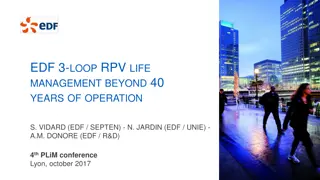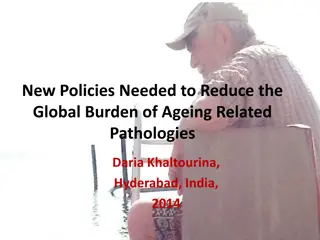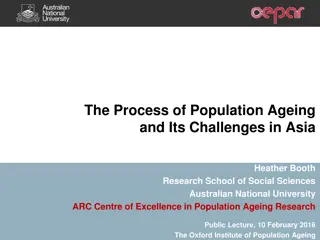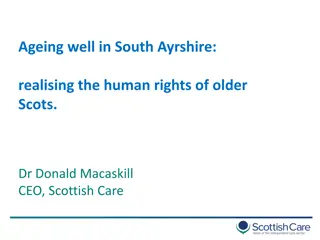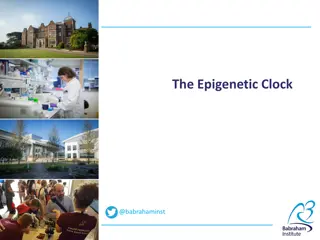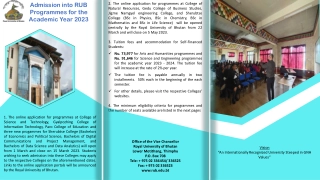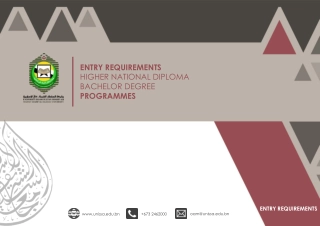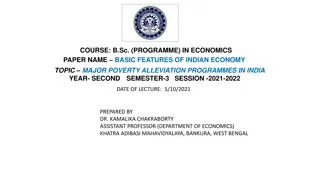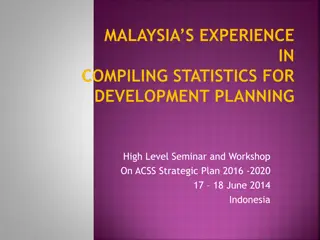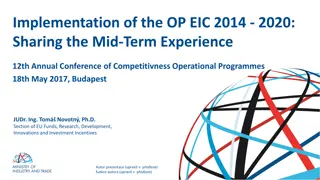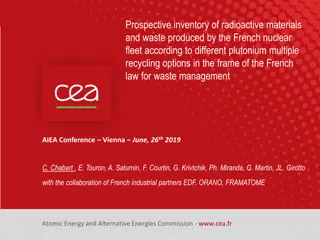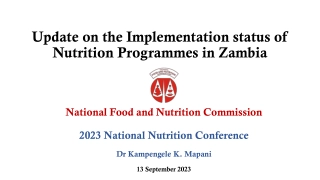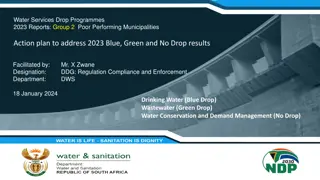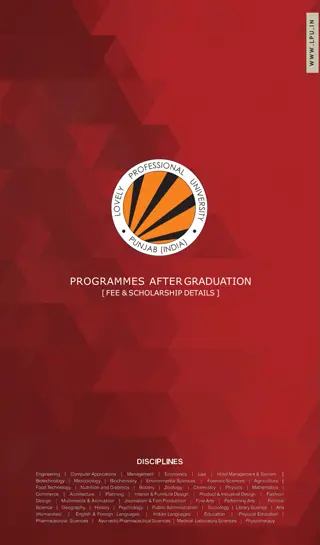EDF Ageing Management R&D Materials Programmes Summary
French nuclear fleet's EDF ageing management focuses on addressing ageing degradation mechanisms through R&D programmes like Metallic Materials Programme. The objectives include evaluating ageing mechanisms, increasing knowledge, and acquiring data for 60-year ageing assessments. The programme involves testing materials in various conditions to ensure they meet design and safety criteria.
Download Presentation

Please find below an Image/Link to download the presentation.
The content on the website is provided AS IS for your information and personal use only. It may not be sold, licensed, or shared on other websites without obtaining consent from the author. Download presentation by click this link. If you encounter any issues during the download, it is possible that the publisher has removed the file from their server.
E N D
Presentation Transcript
EDF AGEING MANAGEMENT: R&D MATERIALS PROGRAMMES J-P MASSOUD, L. GRISY, EDF SEPTEN P. LE DELLIOU, S. SAILLET, P. TODESCHINI, EDF R&D 4th PLIM Conference LYON, October 2017
SUMMARY 1. FRENCH NUCLEAR FLEET SPECIFIC CONTEXT 2. MATERIAL AGEING PROGRAMME 3. FOCUS ON THERMAL AGEING OF METALLIC COMPONENTS - LOW ALLOY STEELS - CAST STAINLESS STEELS - AUSTENITIC STAINLESS STEELS WELDS - DISSIMILAR METAL WELDS - CARBON STEELS - - - - 4. CONCLUSIONS EDF Ageing Management: R&D Materials Programmes | PLIM Lyon - October 2017 | 2
FRENCH NUCLEAR FLEET SPECIFIC CONTEXT The EDF lifetime management policy for LTO (Long Term Operation) of the NPPs is based on three main principles: Regulatory context characterized by 10-year PSR (Periodic Safety Reviews) including continuous safety improvement; Adequate maintenance policy associated with in-service inspections, and performance improvement to increase operational capacities and availability of the units, in compliance with safety requirements; Ageing and obsolescence management process for main NPP safety related components to cope with ageing degradation mechanisms, including operating experience feedback. LTO is supported by R&D programmes such as: 1/3 scaled PWR containment building : Vercors Programme [companion paper N 076] Metallic Materials Ageing Programmes (primary and secondary circuits components) EDF Ageing Management: R&D Materials Programmes | PLIM Lyon - October 2017 | 3
MATERIALS AGEING PROGRAMME The major objectives of the Metallic Materials Programme are: To ensure that all the pertinent ageing mechanisms are evaluated (including potential mechanisms), Increase the knowledge in the areas and technical fields when required, Avoid unfavorable extrapolations due to a lack of data, Acquire needed data for equivalent 60 years ageing to check they remain within the design and safety criteria. EDF Ageing Management: R&D Materials Programmes | PLIM Lyon - October 2017 | 4
MATERIALS AGEING PROGRAMME: METHOD Programmes systematically conducted: for all areas sensitive to ageing or degradation mechanisms on representative materials (archive, or sampled materials, or removed components, or dedicated mock-ups ). Ageing is performed: in lab furnaces up to 100 000 or 200 000 hours (for thermal ageing evaluation), in Test Reactor or Power Reactors (for irradiation damage evaluation), in loops or autoclaves (for corrosion simulations). Materials are tested after (up to) equivalent 60 years ageing times, Measured properties: Mechanical data (toughness, tensile properties, fatigue...), SCC (Stress Corrosion Cracking) data: initiation and propagation, etc. EDF Ageing Management: R&D Materials Programmes | PLIM Lyon - October 2017 | 5
MATERIALS AGEING PROGRAMME: Programmes and actions on primary and secondary circuits components underway include (1/3): Reactor pressure vessel (RPV): Irradiation ageing of the core zone ( RTNDT), [companion paper 052] Austenitic stainless steel cladding toughness, Thermal ageing of low alloy steels (base metals, welds, Heat Affected Zones), PWSCC (initiation and propagation) of nickel based components, RPV internals: Bolts: irradiation embrittlement, irradiation creep, Irradiation Assisted Stress Corrosion Cracking (IASCC), Core barrel, baffles and formers: irradiation embrittlement, potential swelling EDF Ageing Management: R&D Materials Programmes | PLIM Lyon - October 2017 | 6
MATERIALS AGEING PROGRAMME Programmes and actions on primary and secondary circuits components underway include (2/3): Primary loop: Cast Austenitic Stainless Steel (CASS) components (elbows, pump casing, valves....): long term thermal ageing, Homogeneous austenitic stainless steels welds and stainless steel dissimilar metal welds (DMW): potential thermal ageing, SCC: austenitic stainless steel in slightly polluted environment or cold worked, Austenitic and cast duplex stainless steel: fatigue behaviour (mainly initiation) including environmental effects [companion paper in this conference, n 039], Flow assisted corrosion (FAC). EDF Ageing Management: R&D Materials Programmes | PLIM Lyon - October 2017 | 7
MATERIALS AGEING PROGRAMME Programmes and actions on primary and secondary circuits components underway include (3/3): Pressurizer: Thermal ageing (345 C) of low alloy steel pressure boundary components (base metal, welds and heat affected zones), Homogeneous austenitic stainless steels welds of the surge line: thermal ageing, Secondary side: Thermal ageing of carbon steels. Flow assisted corrosion (FAC). EDF Ageing Management: R&D Materials Programmes | PLIM Lyon - October 2017 | 8
MATERIALS AGEING PROGRAM: FOCUS ON THERMAL AGEING All ferritic (or martensitic) steels potentially susceptible to various forms of thermal ageing in the temperature range 300-350 C, Potentially affected components: LAS: mainly PZR (due to high service temperature ~ 350 C), Cast Duplex Stainless Steels: primary circuit tubes, elbows, pump casing, fittings, valves . (due to their ferrite content) Primary Circuit Austenitic Welds (due to their ferrite content), C-Steels of secondary side (thermal ageing + strain ageing). Martensitic Stainless Steels Components: stems, bolting, pump impellers EDF Ageing Management: R&D Materials Programmes | PLIM Lyon - October 2017 | 9
THERMAL AGEING OF LOW ALLOY STEELS (1/2) PWR RPV, SG and PZR steels are designed to have a low susceptibility to thermal ageing at service temperatures (~290 to 350 C) low Phosphorus %, Mo addition, low Cu limited hardness, bainitic microstructure, NPP components may operate for very long times, up to ~500 000 h (~60 years) Knowledge of physical mechanisms suggests that small ageing effects might be possible for such durations and service temperatures. Phosphorus Segregation at Grain Boundaries Potential evolutions of mechanical properties have to be taken into account in the integrity assessement of the components RCC-M (design and manufacturing) and RSE-M (maintenance) codes give DBTT shifts predictions due to thermal ageing An experimental program has been undertaken to validate these predictions with relatively long ageing times (30 000 h) at 300 and 350 C and representative microstructures Base and weld metals, cladding HAZ: coarse and fine grain structures EDF Ageing Management: R&D Materials Programmes | PLIM Lyon - October 2017 | 10
THERMAL AGEING OF LOW ALLOY STEELS (2/2) MAIN RESULTS: For base and weld metals, measured embrittlements are consistent with predictions (RCC-M, RSE-M codes). HAZ embrittlements are more marked but lower than predictions. HAZ Coarse grain structure does not evidence a much higher susceptibility to ageing than the rest of the HAZ. Code predictions are in all cases conservative. Complementary investigations on decommissioned components useful to quantify this conservatism. EDF Ageing Management: R&D Materials Programmes | PLIM Lyon - October 2017 | 11
THERMAL AGEING OF CAST DUPLEX COMPONENTS (1/6) Some components of the primary loops of EDF PWRs are made of static cast duplex SS: elbows, pump casings, branch connections Duplex SS (CF8M and CF3 type) may age at relatively low temperatures, in the temperature range of PWRs service conditions This embrittlement, associated with the presence of casting defects, may increase the risk of failure In a context of life extension, it is important to assess the safety margins to crack initiation and to crack propagation instability No prediction of aged materials properties in the codes: need of specific programmes A very long term experimental programme has been undertaken to develop materials properties predictions EDF Ageing Management: R&D Materials Programmes | PLIM Lyon - October 2017 | 12
THERMAL AGEING OF CAST DUPLEX COMPONENTS (2/6) EXPERIMENTAL R&D PROGRAMME: Thermal Ageing Phenomenon: Duplex SS composed of two phases: ferrite ( 10 to 30% volume) + austenite Micro-structural evolution of the ferritic phase Relevant parameters: ferrite content, w%Cr, w%Si, w%Mo (and w% Ni) Laboratory Ageing Programme Acceptance blocks coming from in-service elbows + R&D products Aging between 285 C and 400 C times up to 200,000 h (25 years!) Charpy impact tests and Fracture toughness tests on CT specimens at 20 C and 320 C Tensile tests, hardness measurements EDF Ageing Management: R&D Materials Programmes | PLIM Lyon - October 2017 | 13
THERMAL AGEING OF CAST DUPLEX COMPONENTS (3/6) MAIN RESULTS: Ageing kinetics / Charpy KCU or KV (RT and 320 C) as a function of equivalent ageing time at 325 C (or 290 C) for more than 50 different materials Correlation Tearing Resistance / Charpy Toughness Prediction formulae of Charpy impact energy and Fracture Toughness of aged cast materials vs initial properties, ferrite content, % Cr, Mo and Si, ageing time and temperature On site ageing monitoring techniques developed to confirm the predictions. EDF Ageing Management: R&D Materials Programmes | PLIM Lyon - October 2017 | 14
THERMAL AGEING OF CAST DUPLEX COMPONENTS (4/6) ON-SITE MONITORING OF COMPONENTS AGEING Non destructive measurements Thermo-Electric Power (TEP) Small Angle Neutron Scattering (SANS) Chemical composition (Cr, Mo, Ni) using portable X-ray fluorescence spectrometry Ferrite content Microhardness measurements Direct measurements of ductile tearing resistance Miniature CT specimens (CT10-5) Boat samples cut by edm process EDF Ageing Management: R&D Materials Programmes | PLIM Lyon - October 2017 | 15
THERMAL AGEING OF CAST DUPLEX COMPONENTS (5/6) LABORATORY STUDY OF REMOVED ELBOWS Some elbows are removed during SGs replacement These elbows are studied in-depth: Metallurgical studies Chemical analysis Mechanical characterization (hardness, tensile tests, Charpy impact tests, toughness tests on CT specimens) Additional aging treatments Removed elbow aged about 200,000 h at 323 C At 325 C or 350 C To reach aging time equivalent to (or beyond) EOL (325,000 h or 500,000 h) J- a tests at 320 C EDF Ageing Management: R&D Materials Programmes | PLIM Lyon - October 2017 | 16
THERMAL AGEING OF CAST DUPLEX COMPONENTS (6/6) CAST DUPLEX METHODOLOGY (SUMMARY): Formulae were developed to predict Charpy impact energy and Fracture Toughness of aged CF8M, CF3 cast components The characterization of numerous shrinkage cavities enabled to define an envelope surface defect FMA is conducted for each type of elbow with the envelope surface defect, taking into account the margin coefficients of the French RSE-M Code Large tests and their detailed analysis contributed to the validation of the integrity assessment of the CASS elbows On-site monitoring of components is also performed to assess the toughness prediction and to follow the most severe manufacturing defects EDF Ageing Management: R&D Materials Programmes | PLIM Lyon - October 2017 | 17
THERMAL AGEING OF AUSTENITIC STAINLESS STEELS WELDS (1/2) Austenitic stainless steels welds may age at PWR in the temperature range of PWRs service conditions Same ageing as cast duplex stainless steels involving ferrite content (although lower ferrite content: up to 10%) Toughness and tearing resistance (J0.2 and J1mm) data on aged SS welds codified in French RSE-M (minimum values) An experimental program has been undertaken to confirm these data for the different types of existing stainless steels welds: Manual Metal Arc (MMA) Gas Tungsten Arc Welding (GTAW) Electroslag Welding (ESW) EDF Ageing Management: R&D Materials Programmes | PLIM Lyon - October 2017 | 18
THERMAL AGEING OF AUSTENITIC STAINLESS STEELS WELDS (2/2) R&D Programme on representative full-scale mockups (thickness 80 mm and 30 mm, ferrite content around 10%) Submerged Arc Weld (SAW) mock-up 76 mm thick, 316L filler metal, 316L base metal Submerged Arc Weld (SAW) mock-up 40 mm thick, 316L filler metal, 316L base metal Orbital TIG Weld (GTAW) mock-up 73 mm thick, 316L filler metal, 316L base metal Long ageing times (up to 30 000 h at 400 C on representative welds) Kinetics of Charpy-Toughness data and Tearing Resistance (J0.2-J1mm) data. Main results: Low sensitivity to thermal aging, Confirm the codified (French RSE-M) data (minimum) EDF Ageing Management: R&D Materials Programmes | PLIM Lyon - October 2017 | 19
THERMAL AGEING OF STAINLESS STEEL DMW (1/2) Dissimilar Metal Welds are located between the ferritic low alloy steel heavy section components and the austenitic stainless steel piping systems. DMW have a specific dilution area between ferritic base metal and SS weld metal, Behaviour and potential ageing of these dilution zones (and HAZ ferritic side) Few Toughness and Tearing Resistance (J0.2and J1mm) existing data An experimental program has been undertaken to complement these data R&D Programme on representative full-scale mockups (thickness 80 mm and 30 mm) with dilution area similar to those existing on actual components Manual Metal Arc (MMA) :16MND5 LAS / 309L-308L stainless steel buttering Gas Tungsten Arc Welding (GTAW): 16MND5 LAS / 309L-308L stainless steel buttering Long ageing times (up to 30 000 h at 400 C) EDF Ageing Management: R&D Materials Programmes | PLIM Lyon - October 2017 | 20
THERMAL AGEING OF STAINLESS STEEL DMW (2/2) R&D PROGRAMME MAIN RESULTS: Charpy and CT fracture toughness at both, the ferritic side (in the Heat Affected Zone) and the stainless steel buttering side of the fusion line were performed Ageing degree rather small, both in the HAZ and in the weld metal near the fusion line (after 10 000 hours / 400 C) On-going aging treatments up to 30 000 hours / 400 C. EDF Ageing Management: R&D Materials Programmes | PLIM Lyon - October 2017 | 21
THERMAL AGEING OF CARBON STEELS (1/2) Toughness and Tearing Resistance (J0.2and J1mmmini values) data on Carbon- Manganese steels (base metal and welds) are codified in French RSE-M code Potential evolutions of mechanical properties due to thermal ageing have to be taken into account in the integrity assessment of the components DBTT shifts due to thermal ageing + strain ageing = 15 C, for killed steels (%Al / %N > 2) or stress-relieved welds An experimental R&D program has been undertaken to confirm the tearing resistance data and DBTT shift due to thermal + strain ageing Characterization of a removed carbon manganese steel elbow (with high sulphur content) Thermal + strain ageing programme on a removed carbon manganese steel elbow and on representative plates (with high Phosphorus content: up to 0.034%) EDF Ageing Management: R&D Materials Programmes | PLIM Lyon - October 2017 | 22
THERMAL AGEING OF CARBON STEELS (2/2) R&D PROGRAMME MAIN RESULTS: Confirmation of the codified (RSE-M) tearing resistance data (minimum values): J0,2 > 92 kJ/m2 at T< 100 C, J0,2 > 55 kJ/m2 at T> 200 C Low sensitivity of carbon manganese steel to thermal aging less than 15 C even for high P content and for severe ageing: 30 000 h at 400 C Low strain ageing effect EDF Ageing Management: R&D Materials Programmes | PLIM Lyon - October 2017 | 23
CONCLUSIONS The Materials programmes are almost completed (RPV and internals irradiation, thermal ageing of CASS, martensitic stainless steels, welds ...). Data are collected in databases and compared with codified values, and, where applicable, predictive formulae are proposed. A few programmes are still in progress (long term thermal ageing of austenitic welds and dissimilar metal welds, fatigue, swelling, IASCC, SCC ..). EDF Ageing Management: R&D Materials Programmes | PLIM Lyon - October 2017 | 24
Thank you for your attention


